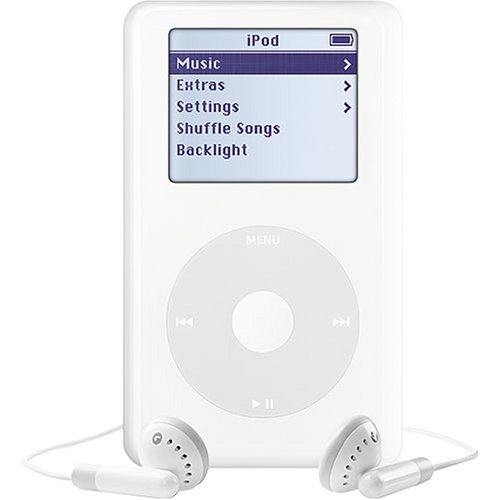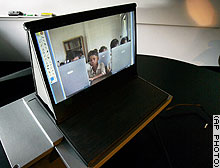
![]() Aural learning. Podcasting your reading assignment. New powers for students to time-shift materials and work. Load up chapter five on your iPod and take it to go.
Aural learning. Podcasting your reading assignment. New powers for students to time-shift materials and work. Load up chapter five on your iPod and take it to go.
Dyslexia’s defeat?
Publishers must be noticing all the earbuds in students’ ears.. how can they make some noise in that space?
But how do you take notes, make annotations on audio? How do you evaluate learning? Could this be anything more than a supplement?
Category Archives: Education
sharing teachers, connecting classrooms
An initiative in Maine is using technology to provide advanced placement programming to high school students in rural areas. The Maine Distance Learning Project “identifies Maine teachers and schools that are interested in offering Advanced Placement programming to be delivered over distance to students in Maine via the state-wide ATM network during the 2005/2006 school year.”
According to a recent article in Newsweek, Reaching Rural Students, support was provided by the University of Maine. The University set up “a network of cameras in AP classes like Brendan Murphy’s calculus and statistics class. These classes were broadcast to five other schools across the state. 90 other schools have a set up like Carrabec’s. Each site’s classroom has a three-foot television screen split into quadrants, and two cameras in each room.”
what’s in a game?
Steven Johnson’s much-discussed book excerpt in the NY Times Magazine challenges the conventional wisdom that television rots the brain, arguing that TV today offers an incredibly rigorous cognitive workout. Multi-threaded narrative, a form first developed on television in soap operas, first found its way into more “serious” programming in the early 80s with Hill Street Blues, and has matured all the way up to the Sopranos, the West Wing and 24. Junk too, Johnson argues, has become more sophisticated. Reality shows like Survivor or the Apprentice explore well-worn territory like sex, money and ambition within a more complex, and at times intentionally confusing matrix, and raise the society of the spectacle to new heights. Much of this, it can be argued, is also influenced by video games, and a large part of Johnson’s book is apparently devoted to this.
On his blog, he brings attention to the question of gaming, and delivers a very funny satire on what would happen if it were actually books that were the new invention that had parents and educators in a frenzy, encroaching on the centuries-old civilization of the video game.
“Reading books chronically under-stimulates the senses. Unlike the longstanding tradition of gameplaying–which engages the child in a vivid, three-dimensional world filled with moving images and musical soundscapes, navigated and controlled with complex muscular movements–books are simply a barren string of words on the page. Only a small portion of the brain devoted to processing written language is activated during reading, while games engage the full range of the sensory and motor cortices.”
It goes on…
Also worth reading is a nice post on Cognitive Daily about the uses of video games in education. And this piece – “Much Fun, For Credit” – from the Sunday Times about the recently instated “Game Arts & Sciences” program at Rensselaer Polytechnic Institute.
the web is like high school
Social networking software is breeding a new paradigm in web publishing. The exponential growth potential of group forming networks is shifting the way we assign value to websites. In paper entitled “That Sneaky Exponential–Beyond Metcalfe’s Law to the Power of Community Building” Dr. David P. Reed, a computer scientist, and discoverer of “Reed’s Law,” a scaling law for group-forming architectures, says: “What’s important in a network changes as the network scale shifts. In a network dominated by linear connectivity value growth, “content is king.” That is, in such networks, there is a small number of sources (publishers or makers) of content that every user selects from. The sources compete for users based on the value of their content (published stories, published images, standardized consumer goods). Where Metcalfe’s Law dominates, transactions become central. The stuff that is traded in transactions (be it email or voice mail, money, securities, contracted services, or whatnot) are king. And where the GFN law dominates, the central role is filled by jointly constructed value (such as specialized newsgroups, joint responses to RFPs, gossip, etc.).”
Reed makes a distinction between linear connectivity value growth (where content is king) and GFNs (group forming networks, like the internet) where value (and presumably content) is jointly constructed and grows as the network grows. Wikipedia is a good example, the larger the network of users and contributors the better the content will be (because you draw on a wider knowledge base) and the more valuable the network itself will be (since it has created a large number of potential connections). He also says that the value/cost of services or content grows more slowly than the value of the network. Therefore, content is no longer king in terms of return on investment.

Does this mean that the web is becoming more like high school, a place where relative value is assigned based on how many people like you? And where popularity is not always a sign of spectacular “content.” You don’t need to be smart, hard-working, honest, nice, or interesting to be the high-school “it” girl (or boy). In some cases you don’t even have to be attractive or rich, you just have to be sought-after. In other words, to be popular you have to be popular. That’s it.
SO…if vigorously networked sites are becoming more valuable, are we going to see a substantial shift in web building strategies and goals–from making robust content to making robust cliques? Dr. Reed would probably answer in the affirmative. His recipe for internet success: “whoever forms the biggest, most robust communities will win.”
abandon all hope, ye who enter here
Silly-sounding business jargon and corporate pep talk abounded at the eBooks in Education Conference at McGraw-Hill in New York. The kind of stuff that makes the eyes and mind glaze over. “Fluidity of work flow.” “Content creation.” “Course-centric versus learner-centric.” The “three-legged stool,” of digital publishing… Books are “learning objects.” A teacher is just a “sage on the stage,” as though teaching were an antiquated idea. Youth is a marketing problem to be solved, the latest batch of young professionals in the making, rolling along the conveyor belt. Tim Magner, a stuffed shirt from our dear own Department of Ed., talked about priming kids for the new global economy (he also took the opportunity to mention that we’re doing the same for Iraq). But nothing about the issues at the heart of education. Nothing about a civil society, an educated citizenry, etc. About nurturing critical faculties in an age of information blitz. About advancing the light against darkness. I don’t doubt the good intentions of many of the speakers and attendees (though I do doubt some) but to someone outside the industry, the conference was plainly nothing more than a congregation of hucksters and homogenizers. Only the accessibility folks (the ones concerned with opening up digital media to people with disabilities), and one soft-spoken tech development manager from the University of Nebraska-Lincoln, seemed to exhibit any kind of public spiritedness, or a belief that technology should be made to serve human beings and not companies.
Then there were the numbing waves of PowerPoint, PowerPoint, PowerPoint! Nothing more perfectly exemplifies the muddled thinking, ignorance of design, and all-around mediocrity of the so-called “ebook industry.” Each presenter – with the exception of George Kerscher of the Daisy Consortium (who is blind) – supplemented their talk with the obligatory PowerPoint presentation, which, after a while, becomes a kind of torture. The slides flip one after the other after the other, the bullet points rattle like hail. Incomprehensible charts and graphs slouch across backgrounds of pastel or mock-marble. There’s a lot of teal. A lot of magenta. The slick veneer of the corporate board room washes over you like microwaved cheese, but the occasional tell-tale typo betrays the obvious haste and lack of consideration with which the things are made. In most cases the presenter abdicates entirely and plays human accompaniment to the PowerPoint show, lamely reading aloud as the panels slide past, sort of like the airline stewardess doing her bit with the oxygen mask while the safety film plays behind. After sitting through a few of these, your brain feels like it’s been flattened out with a rolling pin. I kept thinking of Hart Crane’s lines:
“The mind has shown itself at times
Too much the baked and labeled dough
Divided by accepted multitudes.”
I also thought of Edward Tufte‘s wonderful monograph, “The Cognitive Style of PowerPoint” (encapsulated here), a shrewd critique of sandblasted thinking in Microsoft-era America. It’s a little frightening to hear adults talk about the future of education in the scrubbed, frictionless language of the corporate slideshow. If they are teaching by example, then it is a sorry example indeed.
From Tufte:
“Particularly disturbing is the adoption of the PowerPoint cognitive style in our schools. Rather than learning to write a report using sentences, children are being taught how to formulate client pitches and infomercials. Elementary school PowerPoint exercises (as seen in teacher guides and in student work posted on the Internet) typically consist of 10 to 20 words and a piece of clip art on each slide in a presentation of three to six slides -a total of perhaps 80 words (15 seconds of silent reading) for a week of work. Students would be better off if the schools simply closed down on those days and everyone went to the Exploratorium or wrote an illustrated essay explaining something.”
I couldn’t resist including the cover illustration of Tufte’s piece. which gloriously sends up the totalitarianism of PowerPoint..

the dinosaurs are myopic: publishing industry clueless about the future of textbooks
I spent yesterday in the McGraw-Hill building listening to the textbook publishing industry’s ideas about the future of the book. It was grim. The abysmal lack of creativity and insight, the singular focus on “revenue models,” and the utter disregard for the needs of students and teachers, made for a dull, and sometimes disturbing, day.
The ebook offerings ranged from plain old PDFs, to web-based books, to jury-rigged versions of Microsoft office. The only panel that offered a forward-looking vision of the future and interesting ebook software to go with it was the accessibility panel, moderated by George Kerscher–Secretary General, Daisy consortium–who is blind. This panel included a demo of Dolphin Audio Publishing’s EasePublisher a tool that facilitates the creation of multimedia content that unites text, audio and images. Dolphin and Elsevier were the only companies that addressed multimedia and its role in the future book. While McGraw-Hill is offering PDF textbooks because they are, “the easiest, fastest, cheapest solution.” Dolphin is thinking about how to enrich the learning experience for everyone. They found that when students with no disabilities used their multimedia books, they learned more. Apparently the combination of text (reading), audio (hearing the text read by a human), and image (photos, videos or illustrations that illuminate the material) enhances learning. Designing electronic textbooks that exploit this opportunity seems like a no-brainer. Teachers I’ve spoken to and my own experience with students in the classroom suggests that multi-media ignites student enthusiasm. Making PDF textbooks is like driving a Jaguar in first gear. But after 10 years of experience in the field, McGraw-Hill’s Ginny Moffet believes that: “students only care about the grade,” and “the biggest challenge to the [electronic textbook] industry is the high cost of content creation.” Hmmm, what about making a high quality product that everyone wants to buy, isn’t that the problem they should be trying to solve? It’s clear that the job of making an interesting electronic textbook is not being taken up by any of the old giants. Our prediction (and our hope) is that the future of the electronic textbook will not be directed by corporations, but by small start-ups, or non-profit consortiums of schools and academics. Efforts like the non-profit, Virtual High School, are an interesting beginning.
6th avenue agriculture
 Even before the head of the University of Nebraska library began bemoaning how the pictures had fallen out of their collection of vintage agronomy ebooks, the Open eBook Forum conference on ebooks in education felt a great deal like a convention of cattlemen gathered to discuss the latest advances in treating animal ailments and increasing their milkfat percentages. The cattle, of course, are the hapless students, handily divided into K-12 & college lots. The publishing industry, with the help of the software industry, is doing their best to milk them for all they can.
Even before the head of the University of Nebraska library began bemoaning how the pictures had fallen out of their collection of vintage agronomy ebooks, the Open eBook Forum conference on ebooks in education felt a great deal like a convention of cattlemen gathered to discuss the latest advances in treating animal ailments and increasing their milkfat percentages. The cattle, of course, are the hapless students, handily divided into K-12 & college lots. The publishing industry, with the help of the software industry, is doing their best to milk them for all they can.
The major image that came to my mind, however, was genetically modified corn. Genetically modified corn is theoretically a good thing: you get a bigger harvest of better corn. But! for the good of the masses – so it doesn’t get loose in the wild – Monsanto’s made their GM corn sterile. What this means for their bottom line: the farmers have to buy new seeds every single year. In short, what should be a renewable resource has become corporate property. And this strategy, more or less, is what the people at the Open Ebook Forum were most delighted about having hit upon. They’re selling coursepacks to college kids which expire at the end of the term, ebooks to libraries which only one user can check out at once, and more software to parents so their kids can do their schoolwork. Hopefully, this technology will let you, the efficient new school administrator, get those pesky teachers out of your payroll. Then: profit!
The future of the book looked incredibly bleak from the McGraw-Hill auditorium. One bright spot of enthusiasm: a few groups of people (including Geoff Freed from the CPB/WGBH National Center for Accessible Media and John Worsfeld from Dolphin Computer Access) working on making media more accessible to people with disabilities. Not coincidentally, they were the only people there not primarily concerned with making money off the students.
ebooks in education

![]() if:book will be spending the day at the Open eBook Forum‘s eBooks in Education Conference at the McGraw-Hill Auditorium in New York.
if:book will be spending the day at the Open eBook Forum‘s eBooks in Education Conference at the McGraw-Hill Auditorium in New York.
In the spirit of the conference, here’s an AP article from last week that gives a good overview of Nicholas Negroponte‘s $100 laptop project for developing countries.
“Details are still being worked out, but here’s the MIT team’s current recipe: Put the laptop on a software diet; use the freely distributed Linux operating system; design a battery capable of being recharged with a hand crank; and use newly developed ‘electronic ink’ or a novel rear-projected image display with a 12-inch screen. Then, give it Wi-Fi access, and add USB ports to hook up peripheral devices. Most importantly, take profits, sales costs and marketing expenses out of the picture.”
the kids are good to go: media literacy and the next generation
What would happen if you gave a computer to a group of under-educated kids who had never seen one before? Answer: they would figure out how to use it, all by themselves. Immediately. This is the surprising result of what has come to be known as “the hole in the wall experiment,” conducted by computer scientist, Dr. Sugata Mitra. Dr. Mitra put a computer with internet access in a hole in the wall outside his New Dehli office. According to an article in FRONTLINE/World, “He wanted to see who, if anyone, might use it. To his delight, curious children were immediately attracted to the strange new machine.” All of these children lived in the surrounding slum and had never seen a computer before. However, “Within minutes, children figured out how to point and click. By the end of the day they were browsing. “Given access and opportunity,” observes O’Connor, “the children quickly taught themselves the rudiments of computer literacy.”
The children even developed their own names and associations for the computer icons “They don’t call a cursor a cursor, they call it a sui, which is Hindi for needle. And they don’t call the hourglass symbol the hourglass because they’ve never seen an hourglass before. They call it the damru, which is Shiva’s drum, and it does look a bit like that.”
But the slums of New Dehli are not unique, priviledged kids are also enthusiastic about computers. According to a recent report called “Born to Be Wired”. teens and young adults spend more time using interactive technology than they do watching television. This could mean that are ready for a more interactive and self-guided experience in the classroom. Wise use of media in the curriculum should find ways to exploit this new hunger and allow kids to participate in ways we couldn’t imagine in the past. Jonathan Schwartz, CEO of Sun Microsystems, is calling this “The Participation Age,” a new paradigm for collaborative content creation that seems destined to influence our top-down educational system. The question of how to teach media literacy to kids who seem to grasp these principles intuitively and instantaneously, seems answerable only with a paradigm shift in educational models. Perhaps educators should become more like guides or support persons, providing educational resources and mentor-like advice, empowering kids to engage in self-motivated learning experiences.
weaving textbooks into the web
Mark Crane put forth an interesting possibility for digital textbooks in TechRhet Daily Digest Volume 2: Issue 74: “I’ve been thinking about ways to swap “playlists” of favorite online readings as a sort of virtual textbook, and it occured to me that social bookmarking sites such as del.icio.us and wurldbook might be a way to start to do this. For example, if you collected a series of links related to technical writing, you could publish that “playlist” to a service like del.icio.us and tag the readings as “tech comm” or “tech comm reader” or something for other people to use via a single url, perhaps.”
Mark’s idea is very exciting because it suggests a direction the future textbook might take as it learns to incorporate the vast and ever-expanding body of scholarship available on the web. An ephemeral “links” list could also be attached to a more durable body of content, like an ebook. The electronic textbook could offer these “playlists” as a dynamic index which would be continuously updated by the user community.
